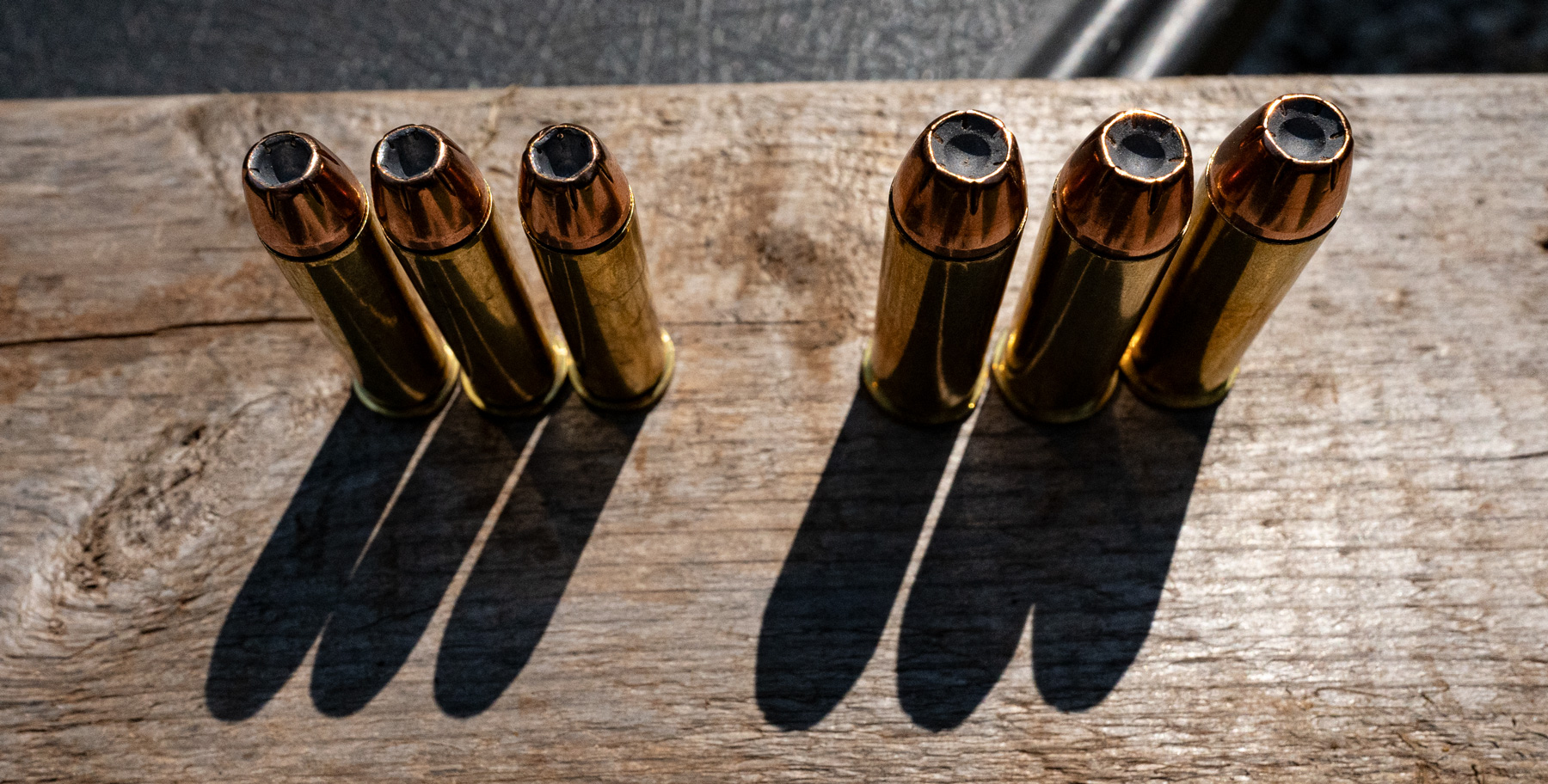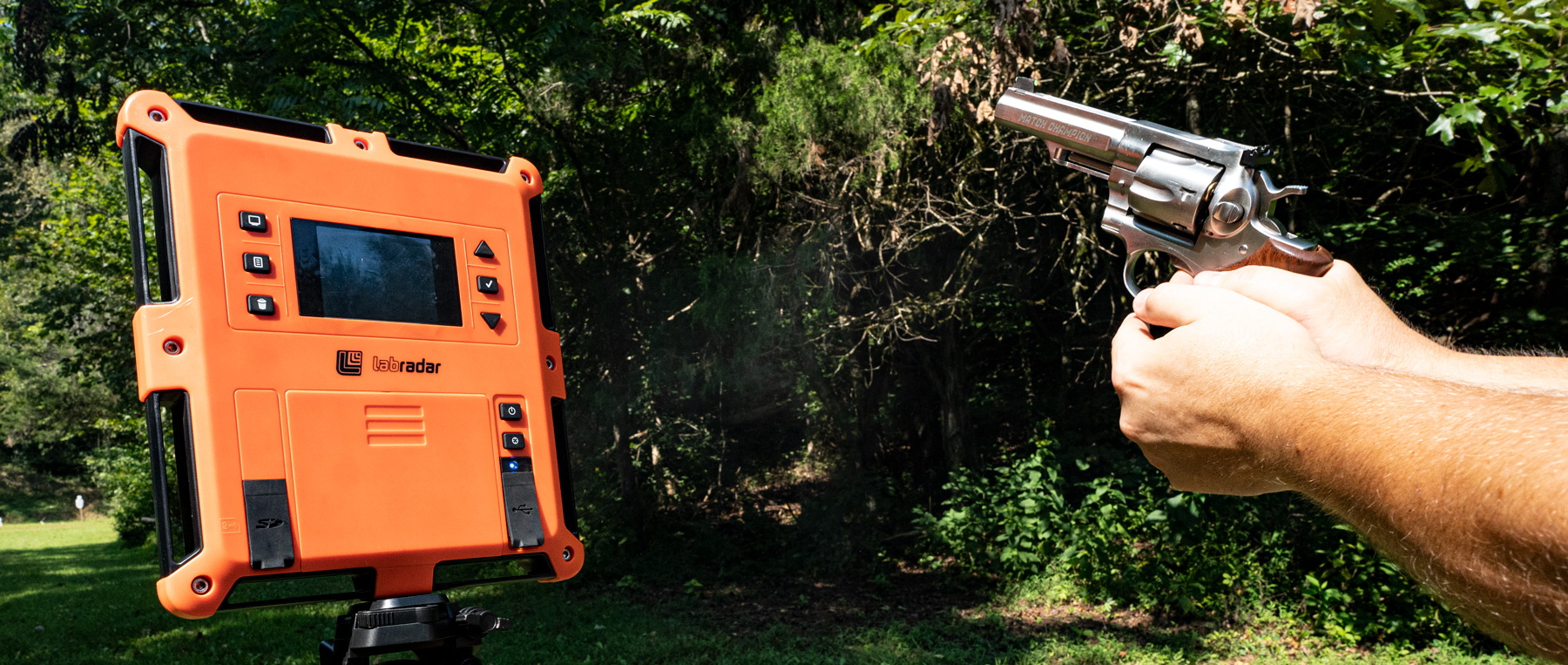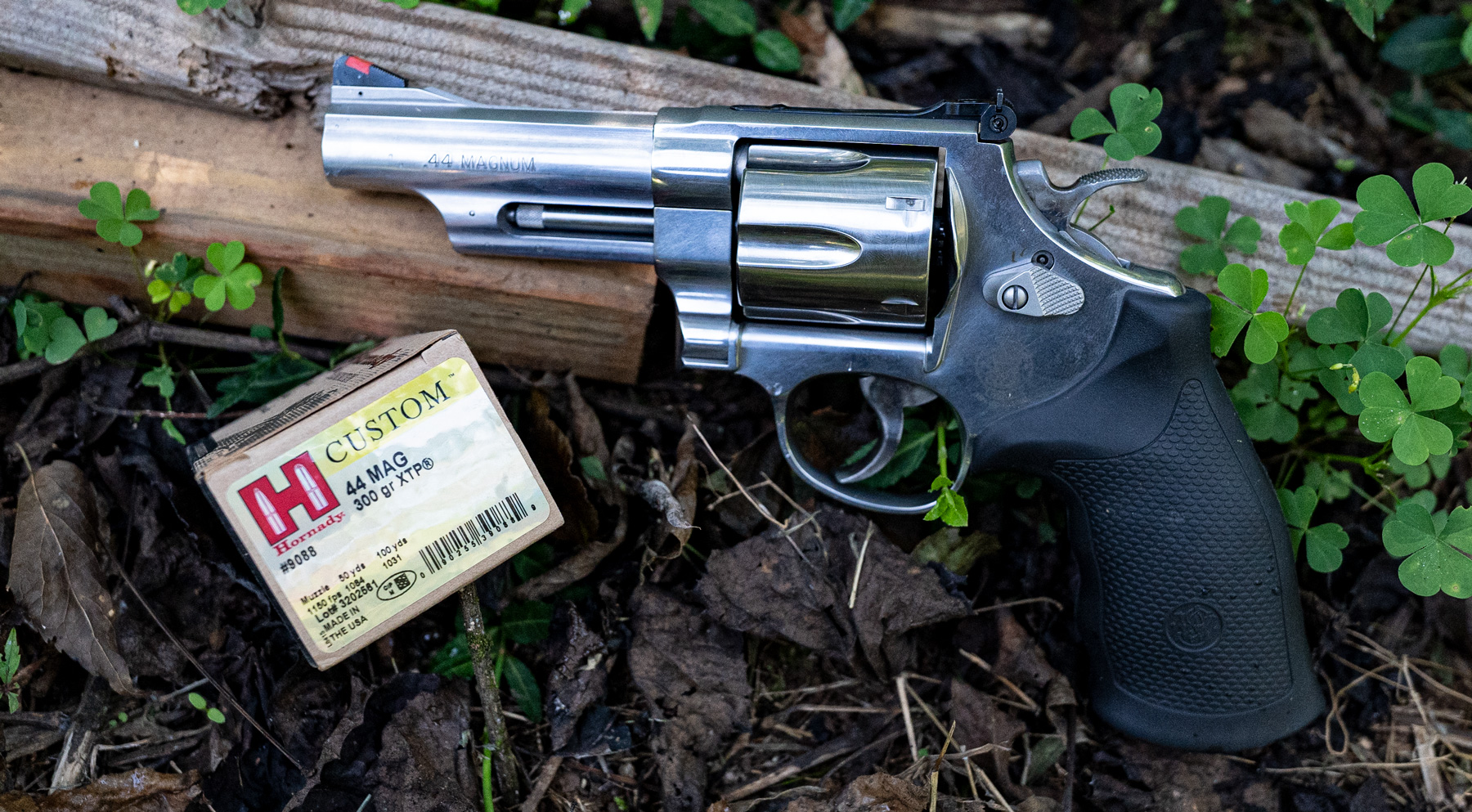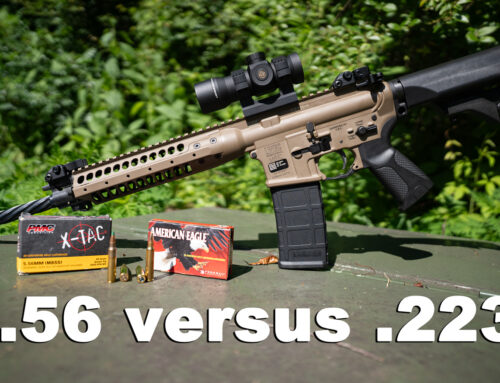So you want to carry a revolver. Good idea. It’s reliable as all get out. Revolvers have far fewer moving parts than a semi-automatic that could fail and leave you defenseless. It is easier to learn how to operate, relying on a single trigger pull to unleash its fury. A revolver’s inherent solidity also means it can pack greater firepower than a comparably sized semi-auto.
Sure, a revolver has a limited shot capacity. It typically takes longer to reload, and has a harder trigger pull too. But those shortcomings would sound pretty acceptable while you’re stuck holding a jammed semi-auto as an axe head plunges in and out of your bedroom door. “Here’s Johnny!”
There are many revolver cartridges to choose from: 38 Special, 44 Special, 454 Casull, 500 S&W Magnum, 45 Long Colt, 41 Magnum – even 22 LR and 22 WMR. But since two of the most popular revolver rounds are 357 Magnum and 44 Magnum, we decided to compare those two rather than write a book comparing every conceivable revolver round to each other. It’s 357 Magnum vs 44 Magnum time!
| 357 Magnum | 44 Magnum | |
|---|---|---|
| Parent case | 38 Special | 44 S&W Special |
| Case type | Rimmed, straight | Rimmed, straight |
| Bullet diameter | .357 in | .429 in |
| Neck diameter | .379 in | .457 in |
| Base diameter | .379 in | .457 in |
| Rim diameter | .440 in | .514 in |
| Rim thickness | .060 in | .060 in |
| Case length | 1.29 in | 1.285 in |
| Overall length | 1.59 in | 1.61 in |
| Case capacity | 26.2 gr H2O | 37.9 gr H2O |
| Maximum pressure | 35,000 psi | 36,000 psi |
Just a glance at the two rounds’ dimensions side by side illustrates the main thing you should take away from this extremely well-written article: The 44 Mag is the more powerful round. It was once the most powerful handgun cartridge in the world, as a matter of fact, even if it only held that title briefly.
The 44 Mag’s case is nearly the same length as the 357 Mag’s, but its greater diameter gives it approximately 45 percent more capacity for propellant. The 44 Mag’s wider case accordingly seats a broader and heavier bullet – two factors that contribute heavily to the greater damage it can inflict.
Ballistics Comparison

44 mag ammo on the left from Black Hills Ammunition. That’s Hornady 357 Magnum on the right.
Let’s be clear: The 357 Mag and 44 Mag offer as great a range of ballistics as there are cartridges to choose from. Each round is available with a variety of bullet weights (357 Mag = 110 to 180 grains; 44 Mag = 180 to 300 grains), which contributes heavily to muzzle velocity. Each manufacturer can load their rounds to different chamber pressures and resultant muzzle velocities. What’s more, the ballistics a round actually exhibits depends a great deal on a handgun’s barrel length.
That said, we can get some comparison of the 357 Mag and 44 Mag by putting a few representative manufacturers’ rounds side by side.
| 357 Mag Hornady Custom 158gr XTP | 44 Mag Hornady Custom 240gr XTP | |
|---|---|---|
| Muzzle velocity (fps) | 1250 | 1350 |
| Velocity @ 50 yds | 1149 | 1230 |
| Velocity @ 100 yds | 1072 | 1133 |
| G1 ballistic coefficient | 0.206 | 0.205 |
| Drop @ 50 yds | -2.67 | -2.3 |
| Drop @ 100 yds | -11.92 | -10.35 |
| Muzzle energy (ft lbs) | 548 | 971 |
| Energy @ 50 yds | 463 | 806 |
| Energy @ 100 yds | 403 | 684 |
| 357 Mag Prvi Partizan 158gr SJHP | 44 Mag Prvi Partizan 240gr JHP | |
| Muzzle velocity (fps) | 1608 | 1542 |
| Velocity @ 50 yds | 1420 | 1381 |
| Velocity @ 100 yds | 1260 | 1243 |
| G1 ballistic coefficient | 0.164 | 0.184 |
| Drop @ 50 yds | -1.66 | -1.78 |
| Drop @ 100 yds | -7.65 | -8.14 |
| Muzzle energy (ft lbs) | 907 | 1267 |
| Energy @ 50 yds | 708 | 1016 |
| Energy @ 100 yds | 557 | 824 |
| 357 Mag American Eagle 158gr JSP | 44 Mag American Eagle 240gr JHP | |
| Muzzle velocity (fps) | 1240 | 1230 |
| Velocity @ 50 yds | 1141 | 1119 |
| Velocity @ 100 yds | 1066 | 1038 |
| G1 ballistic coefficient | 0.206 | 0.175 |
| Drop @ 50 yds | -2.71 | -2.79 |
| Drop @ 100 yds | -12.09 | -12.51 |
| Muzzle energy (ft lbs) | 540 | 806 |
| Energy @ 50 yds | 457 | 667 |
| Energy @ 100 yds | 398 | 574 |
Declaring either round the victor in terms of its velocity, trajectory, or ballistic coefficient is to overlook the fact that there is just so much variety in what either one can offer. On average the 357 Mag does deliver a slightly faster muzzle velocity.
When accompanied by a higher ballistic coefficient contributes to less bullet drop and therefore a flatter trajectory. In general, however, neither round offers an inherently superior ballistic coefficient. Neither will give its shooter a marked accuracy advantage, either. Only training grants that perk.
To sum it all up, comparing these two rounds’ ballistic performances is useful for (A) starting arguments among gun nuts. Or, (B) padding out an article such as the one you are reading.
What’s most important is how these rounds compare to one another in terms of their suitability for self-defense, and that largely boils down to a discussion of stopping power and recoil.
Stopping Power – Self Defense Considerations

357 magnum Hornady hollow point ammo on the left and Hornady 44 magnum hollow points on the right.
Now we’re talking. Unless you’re comparing an unusually weak 44 Mag to an absolute monster of a 357 Mag, the 44 Mag is always going to benefit from an energy advantage. Even at 100 yards the 44 Mag’s bigger, heavier bullet is going to transfer substantially more energy to its target than the 357 Mag could have at the same range.

But here’s the thing: The 357 Mag is no hot house flower. It too is a beast, consistently capable of transferring more than 500 ft lbs of energy at close range. That’s far more than the minimum typically recommended for self-defense, and it’s not as though substantially greater energy is going to make your target even “deader.”
44 Magnum ammunition also boasts superior penetration. This is the product of its bullet’s heavier weight, which grants it greater momentum and “sectional density” (basically a measure of how efficiently a projectile can penetrate its target). But again, unless you’re squaring off against a bear or hunting, the differences in the two rounds’ penetration depth is moot. In fact, the 44 Mag is more likely to overpenetrate a human-sized target, which is undesirable since that puts innocent bystanders at risk.
What About Recoil?

Recoil is an important factor to consider. Heavier recoil doesn’t just make shooting less comfortable – it also lengthens the amount of time it takes to realign your aim for a follow-up shot. Both rounds are generous in the recoil department, but the 44 Mag certainly kicks more
Recoil is determined by four factors: bullet weight, bullet velocity, propellant charge weight, and firearm weight. Now, for our recoil comparison chart let’s just assume that all 357 Mag rounds have 10 grain propellant charges and 44 Mag rounds have 15 grains. Let us also assume we’re firing a 40 ounce 357 Mag Ruger GP100 and a 54 ounce 44 Magnum Redhawk. Given those data, the rounds we compared earlier would deliver the following recoil energies:
| Recoil Energy (ft lbs) | |
|---|---|
| 357 Mag Hornady Custom 158gr XTP | 7.77 |
| 357 Mag Prvi Partizan 158gr SJHP | 11.73 |
| 357 Mag American Eagle 158gr JSP | 7.67 |
| 44 Mag Hornady Custom 240gr XTP | 14.96 |
| 44 Mag Prvi Partizan 240gr JHP | 18.62 |
| 44 Mag American Eagle 240gr JHP | 12.88 |
As you can see, the 44 Mag can consistently deliver twice as much kick as the 357 Mag. This is the natural byproduct of its greater energy. You must either tolerate heavier recoil or get a heavier handgun. Either of these options may dissuade you from carrying a weapon chambered for the larger round.
357 Magnum vs 44 Magnum: Price

No groundbreaking revelation here: The smaller cartridge is also the more affordable one. 357 Magnum ammo is more readily available as well, a testament to its greater popularity.
357 Mag vs. 44 Mag: Takeaway
And why is the 357 Mag more popular? Not because it boasts superior ballistics or accuracy, or necessarily because it is less expensive. It’s because the 357 Mag lets you carry a lighter handgun. It generates less of the recoil that can make firing in self-defense more difficult, and still deals ample energy for neutralizing a human-sized threat. The 357 Mag has been on the market a little longer too. This gave firearm manufacturers more time to produce weapons chambered for it and shooters more time to fully embrace it.
When should you prefer a 44 Mag? It’s energy advantage certainly makes it more capable of taking down larger and dangerous game. Anyone traversing bear country would be well advised to choose a 44 Mag over a 357 Mag. And if you just want to deal as much damage as you can – you know, for fun – or live out your Dirty Harry fantasies, then the answer to the 357 Magnum vs 44 Magnum is the latter.






Seriously both are a POOR choice for home defense, you can blow a big hole in a bad guy then your wall and the neighbors succeeding walls.
I use the .357 mag for Deer backup gun in the timber, and the .44 mag for elk both will knock down either animal at close range (and the occasional small quakie you hit in front of the animal)
awesome hunting round but the damage and recoil make them terrible self defense weapons just by the nature of overkill!!, if you missed a bad guy in your house, he will take you out before you recover for a second shot..
DJ, I disagree entirely. You can purchase factory ammo for both that won’t overpenetrate. and still does excellent damage As far as handguns go, these two are some of the most reliable calibers at stopping human threats quickly.
I disagree, I would go for my 44 magnum before any of my 9mm or any semi-auto because of the reliability of the revolver, and the trajectory of the missed bullets will only be hitting trees. And a leg wound from a 44 will likely result in death before help arrives, especially since I will not call anytime soon.
I have a self defense related question for any and all gun aficionados: what would you reccomend for a single, white female, mid 30s, with a lasting health condition? I personally think the .44 would be too much recoil for me to even fire it without breaking my hand, let alone defending myself, but I will gladly consider all options suggested.
If you’re willing to spend the time and money to train, you could handle either of these cartridges but both are among the larger handgun calibers you could pick.
You might enjoy your training time a bit more with a round like 9mm Luger. It’s not quite as punishing as the 357 magnum or 44 magnum would be. That typically means you’ll spend more time at the range improving to ensure if you ever need to use your pistol in a self-defense situation, you can hit your target on demand.
Lady Smith .38 revolver with laser sights.
A short barrel semi-auto 20 gauge shotgun that You have been instructed in its usage and have shot and loaded enough to feel confident and comfortable. Number 4 buckshot will not go through Your wall and harm the neighbors. First round out the barrel coyote steel shot; after that the #4 buckshot.
You could get a .357 Magnum revolver and train with .38 Special ammo… you have the best of both worlds with a .357 Magnum revolver. I used to shoot and handle the .44 Magnum revolvers quite well, until arthritis settled in on my basil thumb joint in both hands, fortunately I can still handle the .357 Magnum.
Ruger sp101 .357 i have one for self defense definitely dont want the threat to power through a caliber. after least one shot placed good enough,given the many factors come into play when having an intruder threat or big game animal an have to aim an shoot under certain conditions. But if even that is to much of a fun an caliber, for self defense of a human a .38 will do the job to protect your life, animal least a .40 cal or .45
I would go 10mm semi auto.
Ruger sp101 357 magnum loaded with 38 special plus p ammunition
Definitely go down to your local gun range and rent some different guns and try them all out. Even different brands but the same caliber can vary your experience. Even barrel lengths. My wife loves her Browning 1911 style 380 auto with the 4″ barrel. Enjoyable to shoot with very little kick.
I think a shot gun , 410 or 20 gage. But if you want a semiautomatic pistol check out the pmr 30 .22 mag 30 rounds 0 recoil. You do need to break in the magazines/ clips though and get a tool to reload the clips. It takes about three times and keeping the loaded. I have like 9 and none fail after break in.
What none of you mention in your opinions are the fact that you have an adrenaline rush when you have someone entering your house or attacking you. A 9 /45 /44 or any gun u have will do the job. I would personally use a 12 ga more knockdown power and easy to hit the target.
Fair enough Dave – we’d agree that a 12 gauge is ac great tool for home defense.
12 gauge has to be aimed just like any other firearm. At “in home” distance the spread is minimal.
I love 44mag – home defense 45 lc judge
Low impact on a heavy load or buck shot- wall penetration minimal, the desire for a bad guy to continue- non existent
And yet nobody has mentioned the real grandpa badass of defense/war – the LeMat revolver. 9 rounds, .44 chambered with modern replicas by EMF & Pietta.
And if you prefera shotgun shell, it has an under barrel carrying a single 20ga as well.
I went into the store to get a 3 and 1/2 ” S&W M629 44 magnum and walked out with a 357 mag Colt King Cobra. It was not an issue of spending a little more on the S&W. It mainly was that the new KC felt perfectly balanced with a 3″ barrel in my hand, and I have tried a lot of revolvers and semi’s. I am a target guy that felt like buying a revolver. I’ve never been in a defense situation, and hopefully won’t , but it seems like firing a 158 grain hollow point 357 would be enough to change someone’s mind. Plus the gun is sleeker and more manageable, plus no key hole etc. with that extra flimsy metal partition that goes along with it. Less is more. Regarding home defense, am I kidding myself? is a 44 mag still the king of the hill?
It seems if you like guns, its like guitars or any collectible thing, you need more then one, you get pulled into that acquisitive thing, so a good 9mm semi, and a 45, and a 44 etc all start to look “necessary.” And I have had several great semi’s. In truth the only other revolver I ever bought was an old S&W Centennial, hammerless, 38 special for +P. i ended up selling it to a policeman in the store who liked it so much he bought it off me on the spot. Sorry for rambling. The old 357 vs 44 for defense……. I would not want to be hit with either at close range personally, and how do you folks weigh in on that? I guess I have to get a 44 too, and such is the nature of the addictive quality of ownership. there are too many nice things out there
any comments on the S&W model 327 8 shot 357?
A 240 grain bullet traveling at 1350 fps develops 971 lbs of energy…not 639.
Good catch Rich – thank you. We updated it and also adjusted the 50 yard and 100 yard energy values accordingly.
The next conversation should be about lever action rifles. I have a Rossi chambered in .357/.38
This is the most accurate open site rifle I own. AK is a close second. From my research, and testing, the .357 doubles its performance on this platform. With no kick. And I would imagine the .44 magnum would as well. I like the idea of having the same caliber for hand guns and rifles (utilitarian). We all have a .22 handgun and rifle. This lady needs a .357 and shoot .38 out of it all day long cheaply. When it’s put to bed, put the.357 hydra shock ammunition in it and hope nothing happens. But, she can get a lever action rifle that fires all of the same ammunition which could open up a whole new world of fun.
I absolutely loved your comment. I’m in the market to buy a handgun and rifle. Your advice made so much sense for this first time gun buyer. Thank you!
Yes always been a Glock 9mm. But lately they have come out with some outrageous rounds. I carry every day do I want to carry a brick in my pants No No. you all have your opinions especially when it comes to politics and guns but my every day carry is a Smiith and Wesson 642. Ultra light 24oz 48+p. B buffalo bore 400 foot pounds knockdown out of 2 inch barrel oh my God it’s not a 45 nothing works but a 45 until you shot someone or dropped a whole lotta animals. You’re all experts trust me 4 pounds and I can hit you in the head from 15 feet every time I’ll take my little stub nose if that has the work, I’ll pull my knife out get back to my car unload the real shit
I carried a S&W .357 magnum for 7 years as my Police service revolver (1959-1967].I chose it over the .38 Colt. Loved it!